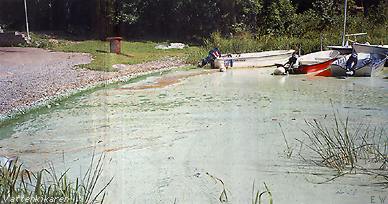 |
|
Different coastal areas vary in sensitivity to over-fertilization depending
on the amount of nutrients that are supplied and how large and quickly the
water exchange is. This implies that the problems caused by over-fertilization
can be combated in different ways depending on the environment. In certain
areas, for example around Tjörn on the Swedish west coast, water exchange
is low, while the delivery of nutrients is high. In such areas, local measures
would be more suitable and effective by reducing the nitrogen delivery.
In other areas, such as around Gotland in the Baltic, the majority of the
nitrogen delivery comes from other coastal areas. Here the problem is not
as acute, but such a large scale problem needs to tackled on a national
and international plane.
Nitrogen or phosphorus?

| Blue-green bacteria can exploit nitrogen gas from
the air and is therefore restricted in its growth by the lack of
phosphorus. Shown above, we see how large quantities of the bacteria
Nodularia spumigena have driven into a small bay. |
The question is, should measures be taken
against nitrogen or phosphorus, or maybe both ? The answer is not easy.
It has been seen that the growth of plant plankton is inhibited by the lack
of nitrogen. An exception is the blooming of the blue-green
bacterias, which are inhibited by the lack of phosphorus. Even the blooming
of algae in the Gulf of Bothnia is inhibited by the lack of phosphorus.
It is difficult to decision to make as to whether it is best
to decrease the discharge of phosphorous or nitrogen. Probably it is best
to lower the discharge of nitrogen along the Swedish coastline, to enable
a decrease in the growth of plant plankton and the finely threaded algae.
 |
Page
22 of 28 |
 |
|



